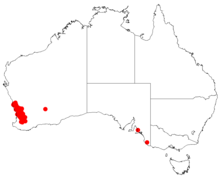Isopogon dubius
Isopogon dubius, the pincushion coneflower, is a small shrub that is endemic to the south-west of Western Australia. It is usually between 0.3 and 1.5 metres high and has divided leaves which are 40 to 50 mm in length[2]
| Isopogon dubius | |
|---|---|
| Isopogon dubius in the Dryandra Woodland | |
| Scientific classification | |
| Kingdom: | Plantae |
| Clade: | Tracheophytes |
| Clade: | Angiosperms |
| Clade: | Eudicots |
| Order: | Proteales |
| Family: | Proteaceae |
| Genus: | Isopogon |
| Species: | I. dubius |
| Binomial name | |
| Isopogon dubius | |
 | |
| Occurrence data from Australasian Virtual Herbarium | |
| Synonyms | |
|
Atylus roseus (Lindl.) Kuntze | |
The deep pink inflorescences are around 50 mm in diameter and appear from July to October in the species' native range.[2][3]
Cultivation
Isopogon dubius was first cultivated in Europe in the 1800s. It prefers dry summers and excellent drainage and will tolerate moderate frosts.[2] Full sun is required for the best flower display, although the plant can be grown in partial shade.[2]
gollark: Why not write your own CC emulator in assembly?
gollark: %d deploy laser bees
gollark: My avatar is not pizza.
gollark: You subtly imply thaf competing products may be filled with bees, you see.
gollark: Maybe https://not-filled-with-bees.pizza?
External links
- "Australian National Botanic Gardens - illustration of Isopogon dubius by Edgar Dell". Retrieved 4 October 2009.
References
| Wikimedia Commons has media related to Isopogon dubius. |
- "Isopogon dubius". Australian Plant Name Index (APNI), IBIS database. Centre for Plant Biodiversity Research, Australian Government.
- "Isopogon dubius". Association of Societies for Growing Australian Plants (ASGAP). Archived from the original on 1 August 2008. Retrieved 10 August 2008.
- "Isopogon formosus". FloraBase. Western Australian Government Department of Parks and Wildlife.
This article is issued from Wikipedia. The text is licensed under Creative Commons - Attribution - Sharealike. Additional terms may apply for the media files.